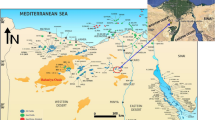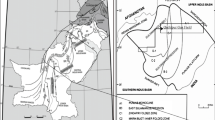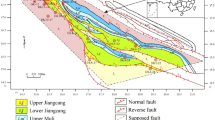Abstract
The reservoir pore structure controls the reservoir quality and resistivity response of hydrocarbon-bearing zones and thus, critically affects logging interpretation. We use petrophysical data in three types of reservoir with different pore structure characteristics to show that the complexity of pore structure had a significant effect on the effective porosity and permeability regardless of geological factors responsible for the formation of pore structure. Moreover,, the distribution and content of conductive fluids in the reservoir varies dramatically owing to pore structure differences, which also induces resistivity variations in reservoir rocks. Hence, the origin of low-resistivity hydrocarbon-bearing zones, except for those with conductive matrix and mud filtrate invasion, is attributed to the complexity of the pore structures. Consequently, reservoir-specific evaluation models, parameters, and criteria should be chosen for resistivity log interpretation to make a reliable evaluation of reservoir quality and fluids.
Similar content being viewed by others
References
Archie, G. E., 1942, The electrical resistivity log as an aid in determining some reservoir characteristics: Trans. AIME, 1942, 146. 54–62.
Bassem, S. N., Géraud, Y., Rochette, P., et al., 2009, Porethroat characterization in highly porous and permeable sandstones: AAPG Bulletin, 93(6), 719–739.
Bian, H. L., Guan, J., and Han, G. Q., 2008, Research of logging interpretation and evaluation method in low resistivity oil and gas reservoir: Well Logging Technology, 32(3), 241–245.
Chen, H., and Heidari, Z., 2014, Pore-scale evaluation of dielectric measurements in formations with complex pore and grain structures: 55th SPWLA Annual Logging Symposium, Abu Dhabi, Paper NNNN.
Gao, C. Q., Mao, Z. Q., and Li, J. F., 1998, The electrical efficiency of rocks and its relationship with water saturation: Geophysical Prospecting for Petroleum, 37(3),130–136.
Gunter, G. W., Spain, D. R., Viro, E. J., Thomas, J. B., Potter, G., and Winland, J. W., 2014, Pore throat prediction method-aproper retrospect: New examples from carbonates and complex systems: 55th SPWLA Annual Logging Symposium, Abu Dhabi, Paper, KKK.
Holden, A., Lehmann, C., Ryder, K., Scott, B., and Almond, K., 2014, Integration of production logs helps to understand heterogeneity of MISHRIF reservoir in RUMAILA: 55th SPWLA Annual Logging Symposium, Abu Dhabi, Paper, GGG.
Kumar, M., Sok, R., Knackstedt, M. A., Latham, S., Senden, T. J., Sheppard, A. P., Varslot, T., 2010, Mapping 3D Pore Scale Fluid Distributions: How Rock Resistivity is Influenced by Wettability and Saturation History: Petrophysics, 51(2),102–117.
Li, C. L., and Li, C. X., 2010, Electrical property analysis on especially low-permeability clastic reservoir: Well logging Technology, 34(3), 233–237.
Li, C. X., Tang, L. M., Hu, F. l., Zhou, C, C., Shi, Y. J., and Xiao, C. W., 2010, On the electrical property of low porosity and low permeability sandstone reservoirs with well developed secondary pore space: 51th SPWLA Annual Logging Symposium, Abu Dhabi, Paper, BBBB.
Li, Q. S., Zhou, R. G., Zhang, J. G., Wu, H. N., and Li, X. S., 2002, Relations between Archie’s formula and Reservoir pore structure: Oil & Gas Geology, 23(4), 364–367.
Liao, M. G., Su, C. H., Tang, H., Tan, D. H., Jiang, W., and Chen, X. Q., 2010, Geological genesis of low resistivity formation with thin sand-shale interlayer: XinJiang Petroleum Geology, 31(2), 154–157.
Lonoy, A., 2006, Making sense of carbonate pore systems: AAPG Bulletin, 90(9),1381–1405.
Lu, G. M., 2010, On the relationship between reservoir micro-pore and low resistivity reservoirs: Journal of Oil and Gas Technology, 32(6), 418–420.
Ma, M. F., Li, W., and Liu, Y. C., 2005, Pore structure characteristics analysis of the oilfield in north Melut Basin, Sudan: Petroleum Exploration and Development, 32(6), 121–124.
Mao, Z. Q., Zhang, Ch. G., Lin, Ch. Z., Ouyang, J., Wang, Q., and Yan, Ch. J., 1995, The effects of pore structure on electrical properties of cores samples from various sandstone reservoirs in tarim basin: 36th SPWLA Annual Logging Symposium, New Orleans, Paper LL.
Ralf, J. W., Gregor, P. E., Gregor, T. B., Jose, L. M., and Sun, Y. F., 2009, Quantification of pore structure and its effect on sonic velocity and permeability in carbonates: AAPG Bulletin, 93(10), 1297–1317.
Shi, J. Y., Li, G. R., and Zhou, J, X., 2008, Study on lithoelectric character and saturation model of argillaceous low-permeability sandstone reservoir: Well Logging Technology, 32(3), 203–206.
Shi, Y. J., Xiao, L., Mao, Z. Q., and Guo, H. P., 2011, An Identification method for diagenetic facies with well logs and its geological significance in low-permeability sandstones: A case study on Chang 8 reservoirs in the Jiyuan region, Ordos Basin: Acta Petrolei Sinica, 32(5), 820–828.
Verwer, K., Eberli, G. P., and Weger, R. J., 2011, Effect of pore structure on electrical resistivity in carbonates: AAPG Bulletin, 95(2), 175–190.
Wang, Q., Zhuo, X. Z., and Chen, G. J., 2005, Diagenetic evolution and high quality reservoir in Chang 6 sandstione in the western Ordos Basin: Acta Petrolei Sinica, 26(5), 17–23.
Wang, X. M., Guo, Y. R., and Fu, J. H., 2005, Control factors for forming higher porosity and permeability sandstone reservoirs in Chang 8 member of Yanchang Formation, Ordos Basin: Petroleum Exploration & Development, 32(2), 35–38.
Wang, Y. C., 1993, Petrophysics: Petroleum Industry Press, Beijing.
Yu, H. Y., Li, H. Q., Guo, B., Sun, H. T., and Zhang, H.X., 2012, Low-Resistivity Oil Layers fine evaluation approaches based on mechanism: Journal of Jilin University (Earth Science Edition), 42(2), 335–343.
Zhang, L. H., Zhou, C. C., Lou, G. Q., and Xiu, L. J., 2006, Influence of pore structures on electric properties and well logging evaluation in low porosity and permeability reservoirs: Petroleum Exploration and Development, 33(6), 671–676.
Zhang, M. L., and Shi, J. Y., 2005, On Archie’s Parameters of sandstone reservoir with complicated pore structures: Well Logging Technology, 29(5), 446–448.
Zhang, S. B., Wang, Q., and Li, X. Y., 2009, Depositionaldiagenetic coupling complex of Xujiahe sandstone in Hebaochang Block in the south part of the Central Sichuan Basin: Acta Petrolei Sinica, 30(2), 225–231.
Zhang, Z. H., Gao, C. H. Q., and Liu, J. J., 2011, The Genetic mechanism of Q4 low-resistivity reservoirs in the North of Honggang Area: Journal of Oil and Gas Technology, 33(11), 89–92.
Author information
Authors and Affiliations
Corresponding author
Additional information
This work is supported by China national petroleum corporation science and technology development projects (No. 2011D_4101).
Bian Huan-Ling, PhD candidate, senior engineer, mainly engaged in integrated interpretation of well logging data.
Rights and permissions
About this article
Cite this article
Bian, HL., Guan, J., Mao, ZQ. et al. Pore structure effect on reservoir electrical properties and well logging evaluation. Appl. Geophys. 11, 374–383 (2014). https://doi.org/10.1007/s11770-014-0462-0
Received:
Revised:
Published:
Issue Date:
DOI: https://doi.org/10.1007/s11770-014-0462-0




